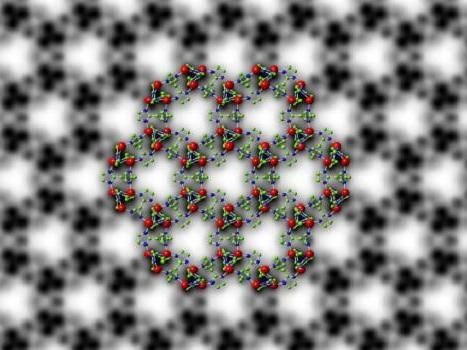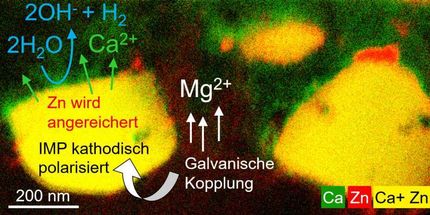High-sensitivity cameras reveal the atomic structure of metal-organic frameworks
Researchers at KAUST have developed a method for fine-scale imaging of metal-organic frameworks (MOFs), three-dimensional structures made up of metal ions connected by organic ligands. MOFs are useful for gas storage and separation because they can be designed to have precise pore sizes of molecular dimensions and large void spaces (porosity) within their frameworks.

This is a symmetry-imposed and lattice-averaged HRTEM image of the metal-organic framework ZIF-8 (black and white) with a structural model overlaid to show the position of the zinc ions and organic ligands (in color).
© 2017 KAUST
Typically, high-resolution transmission electron microscopy (HRTEM) is used to visualize structures with atomic resolution; however, this method is unsuitable for observing MOFs because the electron beams destroy their structures.
"To thoroughly understand the performance of metal-organic frameworks in various applications, we need to know their structures at the atomic level because their macroscopic behavior is determined by their microscopic structure," explained KAUST Associate Professor of Chemical Science Yu Han. By visualizing these structures, researchers can uncover important clues about how these materials self-assemble to create their trademark pores.
Several members of the University's Advanced Membranes and Porous Materials Center, including Han's research scientist and first author of the paper, Yihan Zhu, Associate Professor of Chemical and Biological Engineering Zhiping Lai and Professor of Chemical and Biological Engineering and Director of the Center Ingo Pinnau, joined forces with the University's Imaging and Characterization Core Lab and with colleagues from Gatan, Lawrence Berkeley National Laboratory and others in China. Their collaboration resulted in an adaptation of HRTEM using state-of-the-art direct-detection electron-counting cameras.
The high sensitivity of these detectors enabled them to acquire images with an electron dose low enough that it does not damage the structure of MOFs, allowing the group to produce high-resolution images of their atomic structures.
The team applied their method to ZIF-8, a MOF comprising zinc ions connected by organic 2-methylimidazole linkers. They were able to image its structure with a resolution of 0.21 nanometers (one nanometer is one billionth of a meter), a resolution high enough to image the individual columns of zinc atoms and organic linkers.
This helped the researchers to reveal the surface and interfacial structures of ZIF-8 crystals. "The results unraveled that porosity generated at the interfaces of ZIF-8 crystals is different from the intrinsic porosity of ZIF-8, which influences how gas molecules transport in ZIF-8 crystals," explained Han.
Original publication
Original publication
Yihan Zhu, Jim Ciston, Bin Zheng, Xiaohe Miao, Cory Czarnik, Yichang Pan, Rachid Sougrat, Zhiping Lai, Chia-En Hsiung, Kexin Yao, Ingo Pinnau, Ming Pan & Yu Han; "Unravelling surface and interfacial structures of a metal–organic framework by transmission electron microscopy"; Nature Materials; 2017
Organizations

Get the analytics and lab tech industry in your inbox
By submitting this form you agree that LUMITOS AG will send you the newsletter(s) selected above by email. Your data will not be passed on to third parties. Your data will be stored and processed in accordance with our data protection regulations. LUMITOS may contact you by email for the purpose of advertising or market and opinion surveys. You can revoke your consent at any time without giving reasons to LUMITOS AG, Ernst-Augustin-Str. 2, 12489 Berlin, Germany or by e-mail at revoke@lumitos.com with effect for the future. In addition, each email contains a link to unsubscribe from the corresponding newsletter.
























































